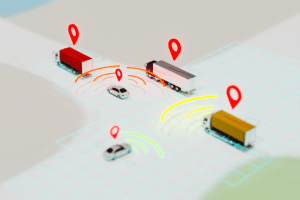Most would know that having a fleet management system is important but is your fleet management system sufficient and performing well enough for you? What constitutes a good or bad fleet management system? This post will explore the various aspects of fleet management in greater detail. Regardless of whether you are currently utilising a fleet management system or not, these are some points that would be helpful to know when looking to select the right fleet management system for your business.
A good fleet management system is one that takes a solution focused approach towards fleet management rather than a hardware based approach. By adopting a solution focused approach, the system will be better geared towards problem solving and meeting the needs of each user. Therefore, a good fleet management system is solution driven with greater flexibility and configurability.
Whereas, a bad fleet management system is one that is excessively hardware based. When a fleet management system is too hardware based, it would result in a more static and one-dimensional system. It will thus lack the capability to provide a comprehensive and targeted solution.
Why is configurability important? Configurability of a system is crucial as there is no one size fits all approach for a fleet management system. Every business is different and may require some tweaks to the system so as to suit their business needs. This is where configuration comes into the picture. Questions to ask yourself when selecting a fleet management system includes the following. To what extent, do you require your fleet management system to be tailored and adjusted to your needs? Also, does the system have the flexibility to allow room for configuration?
Good vs Bad Fleet Management Systems
Control over your insights
Let’s explore how a good fleet management differs from a bad one in terms of reporting capabilities. A bad fleet management is one that can only produce one type of report and does not have the flexibility to configure reports based on the requirements of the business.
On the other hand, a good fleet management system has the ability to generate custom reports. The reports can be modified to suit the needs of the user. Examples of customisation include being able to choose the font, adjust the format and schedule reports. Together with the ability to generate a variety of reports through analytics, a good fleet management system is capable of supplying businesses with the relevant information in a structured manner.
By tapping on advanced telematics, data on fuel consumption which is a major cost component can be obtained. As driver’s behaviour is a factor that has a notable impact on fuel consumption, being able to monitor driving behaviour will be significantly helpful in the implementation of measures to reduce fuel inefficiency. Examples of reports that can be generated include reports on harsh braking, speeding and engine idling which are all causes of high fuel consumption. The information will aid businesses in identifying areas of improvement, thus enabling them to take measures to reduce fuel consumption.
Through taking measures to ensure proper driver’s behaviour, vehicle maintenance can be reduced. In addition to this, reports related to the state of the vehicle can be generated, meaning that vehicle maintenance can be predicted and forecasted in advance. Such reports include reports on vehicle mileage and engine status. Being able to access these reports, leads to greater cost savings as vehicle downtime and incidents of sudden breakdowns will be reduced.
Ability to plan and execute
When you have a fleet to manage, various stops to make and limited time, things could get very hectic and overwhelming. Which routes create the most efficiency and how should the stops be assigned and coordinated? Route optimization, to put in simple terms, refers to finding the best routes for your fleet drivers to take to complete their entire journey. Route optimization is usually an add on module and hence is one extended feature that supports the ability to plan and execute in fleet management. It points out the most cost-efficient route possible, taking into consideration the number of stops, distance and live traffic conditions. This is considered a valuable function as it allows for better fleet scheduling which in turn reduces fuel consumption, saves costs and enhances time efficiency.
In contrast, a bad fleet management system would not offer additional modules that support the planning and execution process, resulting in a great deal of inefficiency and inconvenience. Without route optimization, drivers may get stuck in traffic or unnecessarily take longer routes due to poor planning. All of us can relate to the frustration of being stuck in a traffic jam, imagine the daily frustration the drivers would feel! The inefficiencies would lead to an increase in fuel consumption, resulting in the incurrence of a higher cost which could have been well-avoided had a good fleet management system been in place. Moreover, if the drivers feel displeased and exhausted it could also potentially increase the turnover rate, adding to costs.
Integrating with systems
Interoperability refers to the ability of different systems or software to exchange information and work together with one another. Application Programming Interface (API) plays an important role in supporting this. A system should be easily configurable and have ready APIs to ensure interoperability. Therefore, a good fleet management system should be API ready and capable of supporting integration to existing customer systems. Interoperability is important because it ensures the smooth communication between systems and promotes a more cohesive, productive and efficient way of operation.
API plays a role similar to a messenger by allowing the efficient exchange of information back and forth between systems. For example, if businesses want to integrate their ERP or CRM to a fleet management system, they will be able to do so through the use of APIs.
Scalability and sensibility
The scalability and sensibility of a fleet management system contributes to the configurability. The ability of a fleet management system to tap on IoT sensors along with GPS tracking to offer more insights on the status of the cargo, is a form of scalability and sensibility. Take for example, if you are a company that manufactures and distributes ice cream, you would want to be able to track the temperature of your cargo in transit. Doing so ensures the quality of your product. There is also a sense of assurance as you will be able to respond quickly to any real time temperature fluctuation. The data gathered throughout the trip can be analysed to see if there are any improvements that can be made to the transportation process.
A good fleet management system should also be capable of growing with your business. Suppose that your business expands in size, a few years after the purchase of a fleet management system. When this happens, what you require from a fleet management system could potentially change as well. Hence, a fleet management system needs to be flexible and scalable so as to be able to adapt accordingly to the new demands of a larger business.
The cost associated with configuration must be flexible. This is because the cost has to be reasonable and within an affordable range. If the cost is too high and expensive, it could outweigh the cost savings from increased efficiency. A good fleet management system is one that is able to offer configuration at a reasonable price.
The right fleet management system
A solution focused fleet management system is dynamic, flexible and configurable. These qualities are what makes a good fleet management system. It is of utmost importance to choose an appropriate system that works for your business. One that is able to bring about close to maximum operational, time and cost efficiency for your business.
Check out our iSPOT® FMS to learn about our fleet management solutions.



